Engine Peugeot 206 SW 2003 Service Manual
[x] Cancel search | Manufacturer: PEUGEOT, Model Year: 2003, Model line: 206 SW, Model: Peugeot 206 SW 2003Pages: 171, PDF Size: 2.12 MB
Page 136 of 171
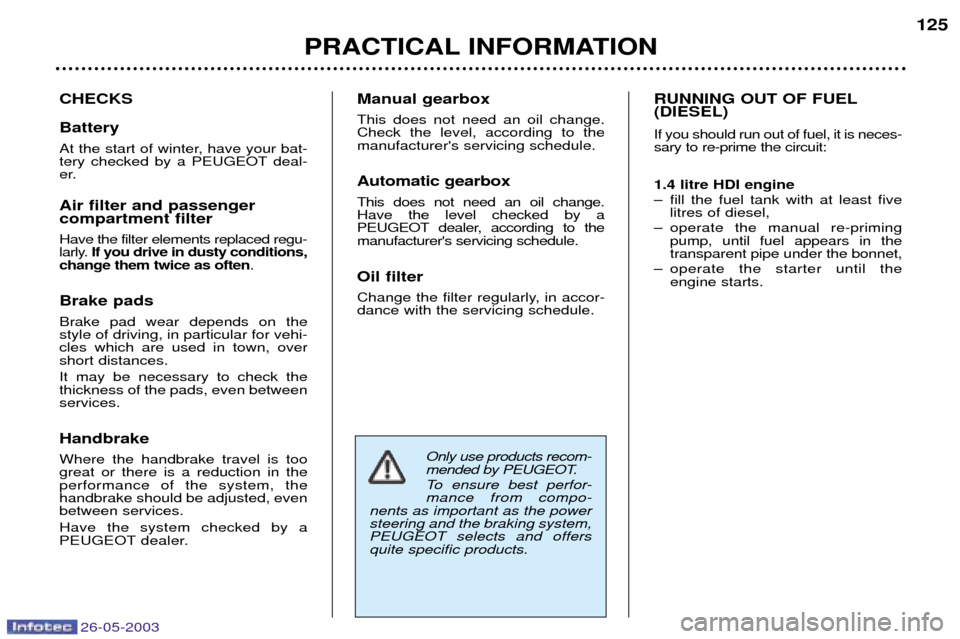
26-05-2003
PRACTICAL INFORMATION125
CHECKS Battery
At the start of winter, have your bat-
tery checked by a PEUGEOT deal-
er. Air filter and passenger compartment filter Have the filter elements replaced regu-
larly. If you drive in dusty conditions,
change them twice as often .
Brake pads Brake pad wear depends on the style of driving, in particular for vehi-cles which are used in town, overshort distances. It may be necessary to check the thickness of the pads, even betweenservices. Handbrake Where the handbrake travel is too great or there is a reduction in theperformance of the system, thehandbrake should be adjusted, evenbetween services. Have the system checked by a
PEUGEOT dealer. Manual gearbox This does not need an oil change. Check the level, according to themanufacturer's servicing schedule. Automatic gearbox This does not need an oil change. Have the level checked by a
PEUGEOT dealer, according to themanufacturer's servicing schedule. Oil filter
Change the filter regularly, in accor- dance with the servicing schedule.
Only use products recom-
mended by PEUGEOT.
To ensure best perfor- mance from compo-
nents as important as the powersteering and the braking system,PEUGEOT selects and offersquite specific products.
RUNNING OUT OF FUEL (DIESEL) If you should run out of fuel, it is neces- sary to re-prime the circuit: 1.4 litre HDI engine
Ð fill the fuel tank with at least five litres of diesel,
Ð operate the manual re-priming pump, until fuel appears in the transparent pipe under the bonnet,
Ð operate the starter until the engine starts.
Page 151 of 171
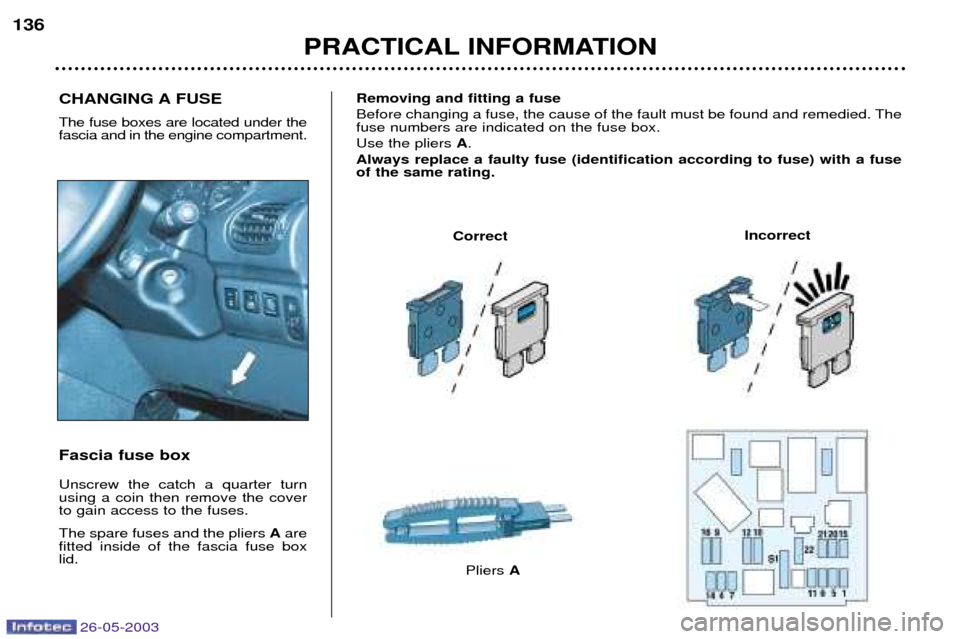
26-05-2003
CHANGING A FUSE The fuse boxes are located under the fascia and in the engine compartment. Fascia fuse box Unscrew the catch a quarter turn using a coin then remove the coverto gain access to the fuses. The spare fuses and the pliers Aare
fitted inside of the fascia fuse box lid.
PRACTICAL INFORMATION
136
Removing and fitting a fuse
Before changing a fuse, the cause of the fault must be found and remedied. The fuse numbers are indicated on the fuse box. Use the pliers A.
Always replace a faulty fuse (identification according to fuse) with a fuse of the same rating.
Correct
Pliers A Incorrect
Page 152 of 171
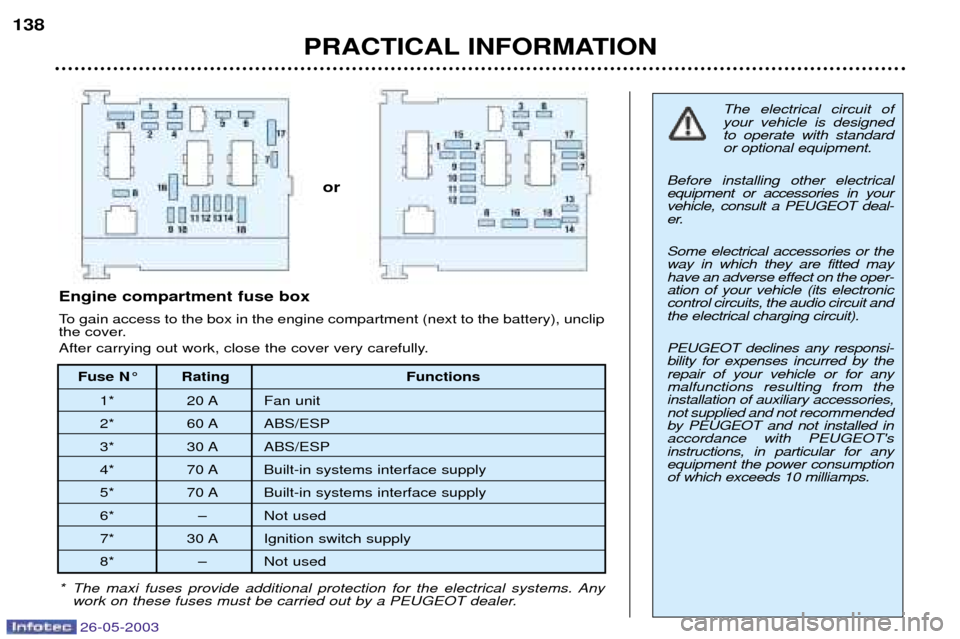
26-05-2003
PRACTICAL INFORMATION
138
The electrical circuit of your vehicle is designedto operate with standardor optional equipment.
Before installing other electricalequipment or accessories in yourvehicle, consult a PEUGEOT deal-
er. Some electrical accessories or the way in which they are fitted mayhave an adverse effect on the oper-ation of your vehicle (its electroniccontrol circuits, the audio circuit andthe electrical charging circuit). PEUGEOT declines any responsi- bility for expenses incurred by therepair of your vehicle or for anymalfunctions resulting from theinstallation of auxiliary accessories,not supplied and not recommendedby PEUGEOT and not installed inaccordance with PEUGEOT'sinstructions, in particular for anyequipment the power consumptionof which exceeds 10 milliamps.
* The maxi fuses provide additional protection for the electrical systems. Any work on these fuses must be carried out by a PEUGEOT dealer.
Fuse N¡ Rating Functions
1* 20 A Fan unit
2* 60 A ABS/ESP
3* 30 A ABS/ESP
4* 70 A Built-in systems interface supply
5* 70 A Built-in systems interface supply
6* Ð Not used
7* 30 A Ignition switch supply
8* Ð Not used
Engine compartment fuse box
To gain access to the box in the engine compartment (next to the battery), unclip
the cover.
After carrying out work, close the cover very carefully.
or
Page 153 of 171
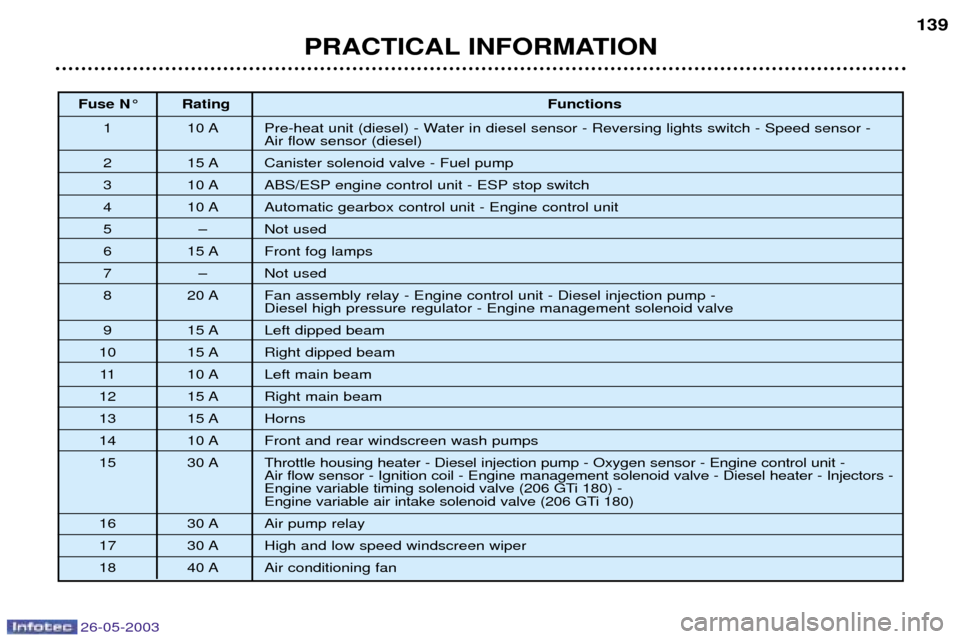
26-05-2003
PRACTICAL INFORMATION139
Fuse N¡ Rating
Functions
1 10 A Pre-heat unit (diesel) - Water in diesel sensor - Reversing lights switch - Speed sensor - Air flow sensor (diesel)
2 15 A Canister solenoid valve - Fuel pump
3 10 A ABS/ESP engine control unit - ESP stop switch
4 10 A Automatic gearbox control unit - Engine control unit
5 Ð Not used
6 15 A Front fog lamps
7 Ð Not used
8 20 A Fan assembly relay - Engine control unit - Diesel injection pump - Diesel high pressure regulator - Engine management solenoid valve
9 15 A Left dipped beam
10 15 A Right dipped beam 11 10 A Left main beam
12 15 A Right main beam
13 15 A Horns
14 10 A Front and rear windscreen wash pumps
15 30 A Throttle housing heater - Diesel injection pump - Oxygen sensor - Engine control unit - Air flow sensor - Ignition coil - Engine management solenoid valve - Diesel heater - Injectors -
Engine variable timing solenoid valve (206 GTi 180) -
Engine variable air intake solenoid valve (206 GTi 180)
16 30 A Air pump relay
17 30 A High and low speed windscreen wiper
18 40 A Air conditioning fan
Page 154 of 171
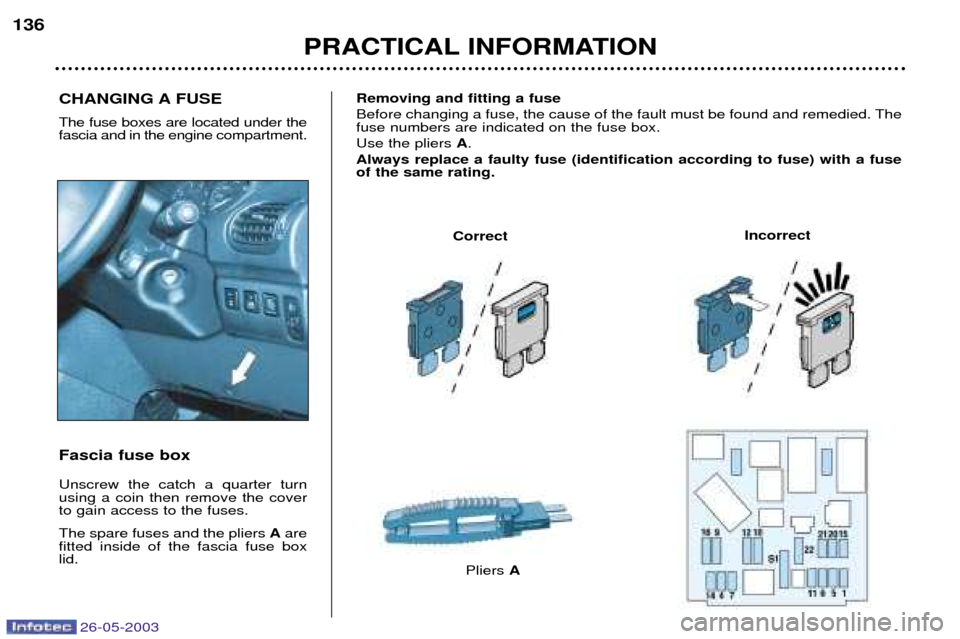
26-05-2003
CHANGING A FUSE The fuse boxes are located under the fascia and in the engine compartment. Fascia fuse box Unscrew the catch a quarter turn using a coin then remove the coverto gain access to the fuses. The spare fuses and the pliers Aare
fitted inside of the fascia fuse box lid.
PRACTICAL INFORMATION
136
Removing and fitting a fuse
Before changing a fuse, the cause of the fault must be found and remedied. The fuse numbers are indicated on the fuse box. Use the pliers A.
Always replace a faulty fuse (identification according to fuse) with a fuse of the same rating.
Correct
Pliers A Incorrect
Page 155 of 171
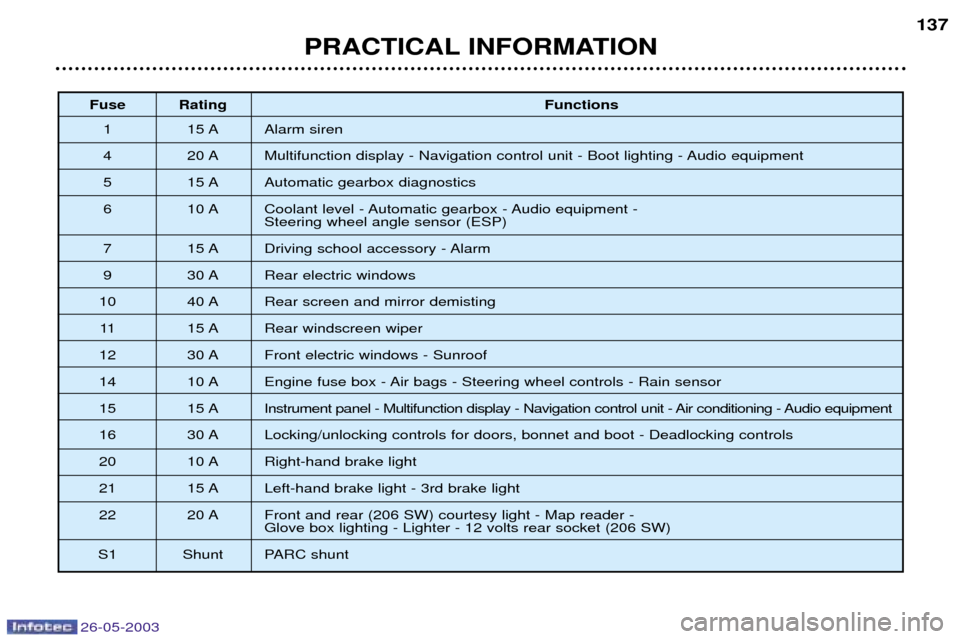
26-05-2003
PRACTICAL INFORMATION137
Fuse Rating
Functions
1 15 A Alarm siren
4 20 A Multifunction display - Navigation control unit - Boot lighting - Audio equipment
5 15 A Automatic gearbox diagnostics
6 10 A Coolant level - Automatic gearbox - Audio equipment - Steering wheel angle sensor (ESP)
7 15 A Driving school accessory - Alarm
9 30 A Rear electric windows
10 40 A Rear screen and mirror demisting
11 15 A Rear windscreen wiper
12 30 A Front electric windows - Sunroof
14 10 A Engine fuse box - Air bags - Steering wheel controls - Rain sensor
15 15 A Instrument panel - Multifunction display - Navigation control unit - Air conditioning - Audio equipment
16 30 A Locking/unlocking controls for doors, bonnet and boot - Deadlocking controls
20 10 A Right-hand brake light
21 15 A Left-hand brake light - 3rd brake light
22 20 A Front and rear (206 SW) courtesy light - Map reader - Glove box lighting - Lighter - 12 volts rear socket (206 SW)
S1 Shunt PARC shunt
Page 156 of 171

PRACTICAL INFORMATION
140
BATTERY
To charge the battery using a battery charger:
Ð Disconnect the battery,
Ð Follow the instructions for use given by the battery charger manufacturer,
Ð Reconnect starting with the negative (Ð) terminal,
Ð Check that the terminals and connectors are clean. If they are covered withsulphate (white or greenish deposit), disconnect them and clean them.
To start the vehicle from another battery:
Ð Connect the red cable to the positive (+) terminals of the two batteries,
Ð Connect one end of the green or black cable to the negative (Ð) terminal of the slave battery,
Ð Connect the other end of the green or black cable to an earth point on the bro- ken down vehicle as far as possible from the battery,
Operate the starter, let the engine run.
Wait for the engine to return to idle, then disconnect the cables.
Ð Before disconnecting the battery, you must wait for 2 minutes after switching off the ignition.
Ð Never disconnect a terminal when the engine is running.
Ð Never charge a battery without first disconnecting the terminals.
Ð Close the windows and sunroof before disconnecting the battery. If they do not operate normally following reconnection of the battery, they must be reintialised (see sections "Electric windows - Safety auto-reverse" and"Sunroof - Safety auto-reverse".
Ð After every reconnection of the battery, switch on the ignition and wait 1 minute before starting to allow the electronic systems to be initialised. Ifslight difficulties are experienced after this, please contact a PEUGEOT
dealer.
It is advisable to disconnect the battery if the vehicle is not to be used for a period of more than one month.
ECONOMY MODE FUNCTION After the engine has stopped, with the key in the accessories position,
certain functions (windscreen wiper,electric windows, courtesy lights,audio equipment etc.) can only beused for thirty minutes, to prevent
discharging the battery.
Once the thirty minutes are over, the message "Economy mode active"
appears on the multifunction displayand the active functions are put on
standby.
A flat battery will prevent the engine from starting.
26-05-2003
Page 159 of 171
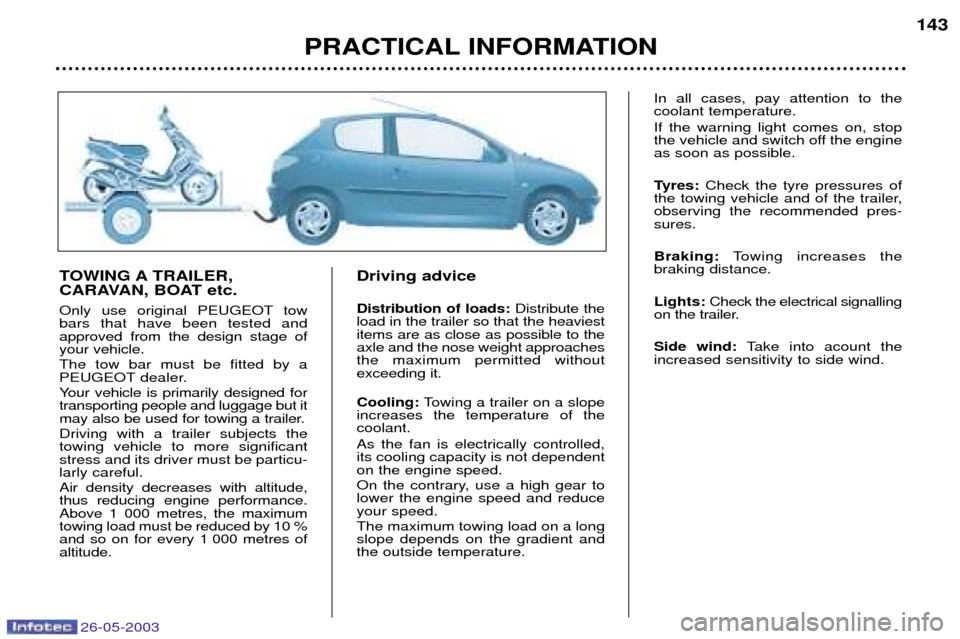
26-05-2003
PRACTICAL INFORMATION143
TOWING A TRAILER,
CARAVAN, BOAT etc.
Only use original PEUGEOT tow bars that have been tested andapproved from the design stage ofyour vehicle. The tow bar must be fitted by a
PEUGEOT dealer.
Your vehicle is primarily designed for transporting people and luggage but it
may also be used for towing a trailer. Driving with a trailer subjects the towing vehicle to more significantstress and its driver must be particu-larly careful. Air density decreases with altitude, thus reducing engine performance.Above 1 000 metres, the maximumtowing load must be reduced by 10 %
and so on for every 1 000 metres ofaltitude. Driving advice Distribution of loads:
Distribute the
load in the trailer so that the heaviest items are as close as possible to theaxle and the nose weight approachesthe maximum permitted withoutexceeding it. Cooling: Towing a trailer on a slope
increases the temperature of the coolant. As the fan is electrically controlled, its cooling capacity is not dependenton the engine speed.
On the contrary, use a high gear to lower the engine speed and reduceyour speed. The maximum towing load on a long slope depends on the gradient andthe outside temperature. In all cases, pay attention to thecoolant temperature. If the warning light comes on, stop
the vehicle and switch off the engineas soon as possible.
Tyres:
Check the tyre pressures of
the towing vehicle and of the trailer, observing the recommended pres-sures. Braking: Towing increases the
braking distance. Lights: Check the electrical signalling
on the trailer.Side wind: Take into acount the
increased sensitivity to side wind.
Page 163 of 171
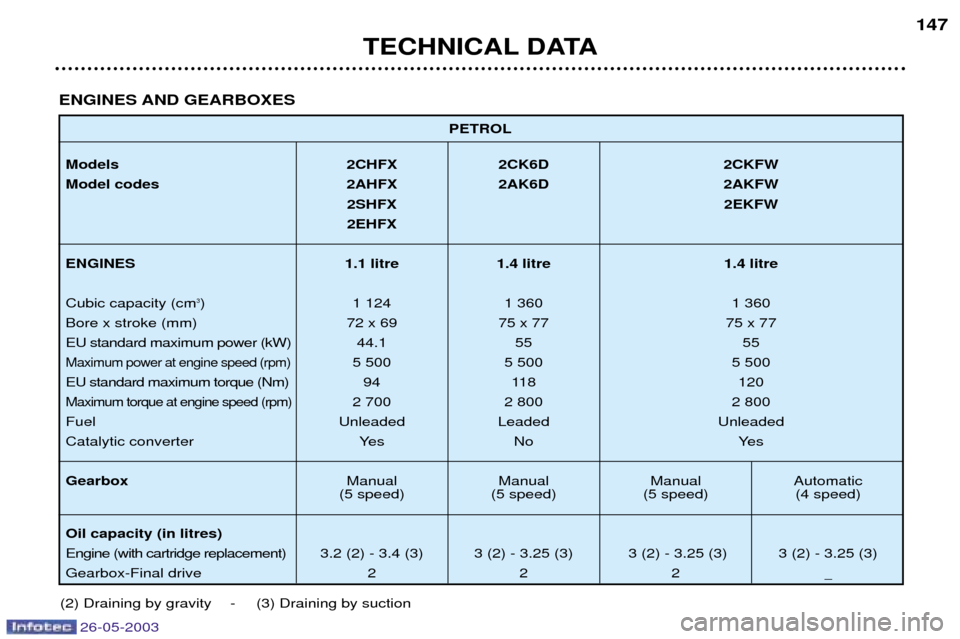
TECHNICAL DATA147
PETROL
Models 2CHFX 2CK6D 2CKFW
Model codes 2AHFX 2AK6D 2AKFW 2SHFX 2EKFW
2EHFX
ENGINES 1.1 litre 1.4 litre 1.4 litre Cubic capacity (cm
3) 1 124 1 360 1 360
Bore x stroke (mm) 72 x 69 75 x 77 75 x 77 EU standard maximum power (kW) 44.1 55 55
Maximum power at engine speed (rpm)5 500 5 500 5 500
EU standard maximum torque (Nm) 94 118 120
Maximum torque at engine speed (rpm)2 700 2 800 2 800
Fuel Unleaded Leaded Unleaded
Catalytic converter Yes No Yes Gearbox Manual Manual Manual Automatic
(5 speed) (5 speed) (5 speed) (4 speed)
Oil capacity (in litres) Engine (with cartridge replacement) 3.2 (2) - 3.4 (3) 3 (2) - 3.25 (3) 3 (2) - 3.25 (3) 3 (2) - 3.25 (3)
Gearbox-Final drive 2 2 2
_
ENGINES AND GEARBOXES
(2) Draining by gravity - (3) Draining by suction
26-05-2003
Page 164 of 171
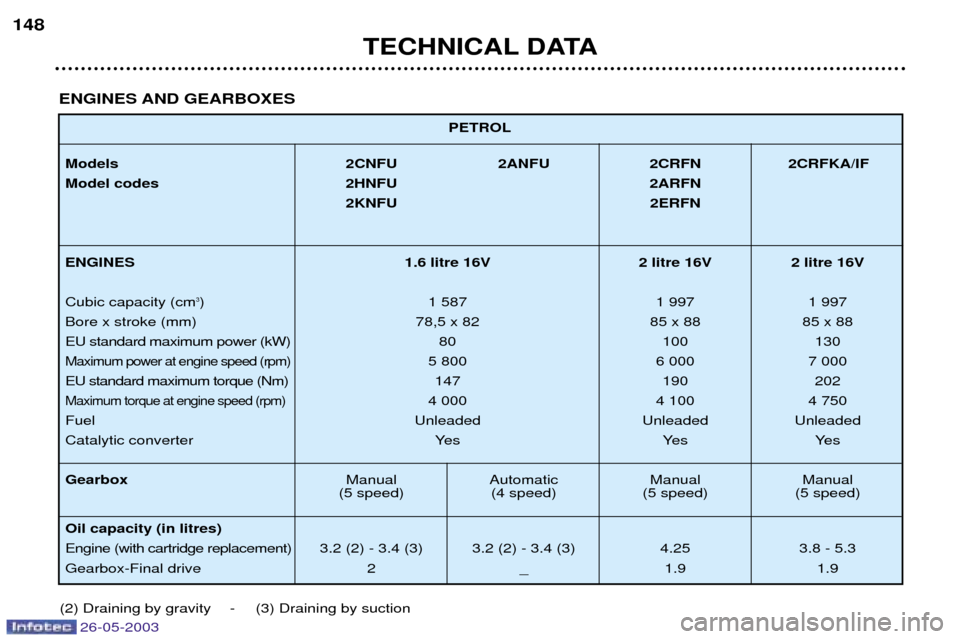
PETROL
Models 2CNFU 2ANFU 2CRFN 2CRFKA/IF
Model codes 2HNFU 2ARFN 2KNFU 2ERFN
ENGINES 1.6 litre 16V 2 litre 16V 2 litre 16V
Cubic capacity (cm
3) 1 587 1 997 1 997
Bore x stroke (mm) 78,5 x 82 85 x 88 85 x 88
EU standard maximum power (kW) 80 100 130
Maximum power at engine speed (rpm)5 800 6 000 7 000
EU standard maximum torque (Nm) 147 190 202
Maximum torque at engine speed (rpm)4 000 4 100 4 750
Fuel Unleaded Unleaded Unleaded
Catalytic converter Yes Yes Yes Gearbox Manual Automatic Manual Manual
(5 speed) (4 speed) (5 speed) (5 speed)
Oil capacity (in litres) Engine (with cartridge replacement) 3.2 (2) - 3.4 (3) 3.2 (2) - 3.4 (3) 4.25 3.8 - 5.3
Gearbox-Final drive 2 _ 1.9 1.9
TECHNICAL DATA
148
(2) Draining by gravity - (3) Draining by suction
ENGINES AND GEARBOXES
26-05-2003